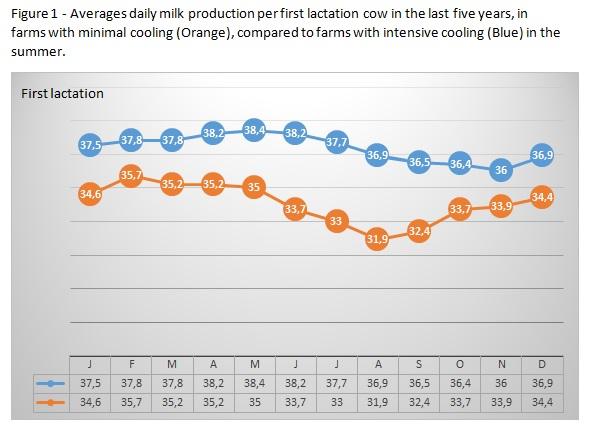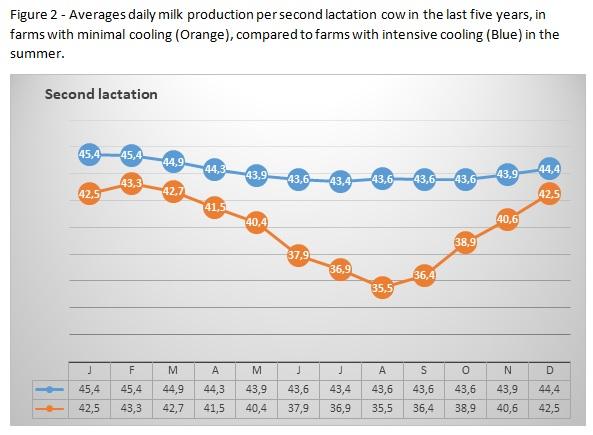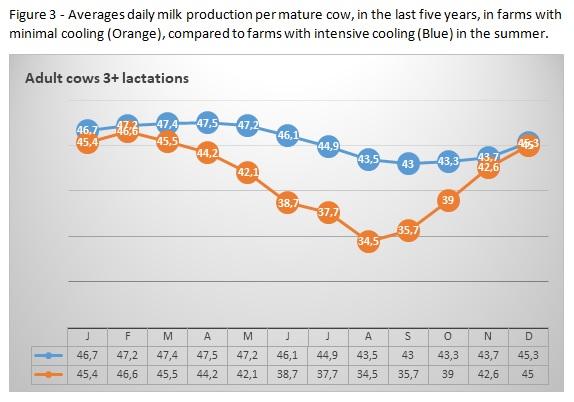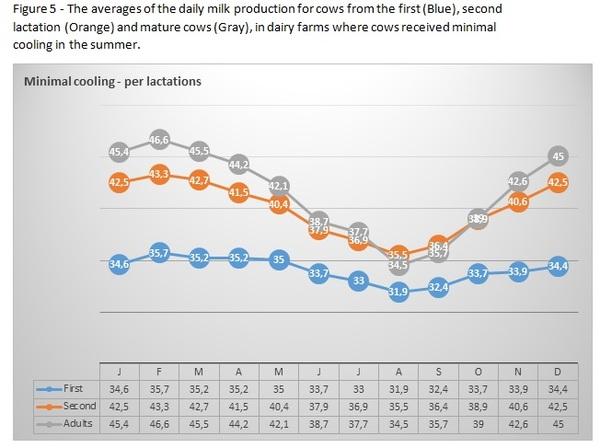Increase in milk production due to intensive cow cooling
How much milk adds intensive cooling in the summer to the annual yield of young and mature cows
Published: November 23, 2023
By: Israel Flamenbaum, Ph. D / Cow Cooling Solutions, Ltd.
Global warming and the constant increase in cow’s milk yield exacerbate the summer problem in dairy farms and increase the production loss caused to milk producers. In order to quantify these losses, I collected data from five large scale high yielding dairy farms (1,500 to 3,000 cows per herd), located in the Torreon region, north Mexico, characterized by a desert climate, with close to 180 stressful days, where cows are exposed to heat stress conditions. Despite the desire to compare dairy farms, with intensive cooling with those without it at all, it turned out to us that there are no such farms in that region. What could be found is only two dairy farms where cows received a minimal cooling treatment that combined wetting and forced ventilation in the waiting yard, only before each milking session. The data from the farms with minimal cooling was compared to that of three dairy farms where cows received intensive cooling that combines wetting and forced ventilation, provided in 6 cooling treatments a day, lasting one hour each, given before and between milking sessions, one almost every 4 hours, throughout the day.
In this article, I present monthly averages of per cow daily milk production, in the last five years (2019-2023), in the farms with minimal and intensive cooling treatment.
In the following three figures, the averages of the daily milk production per cow in the last five years are shown, for first and second lactation cows, as well as mature cows (three lactations and more).



Figures 4 and 5 describe the production curves for the three age groups, in farms with minimal and intensive cooling.


The findings presented in Figures 1-5 are shown in Table 1, where daily and annual milk yield per cow, for cows from various ages, as well as the increase in milk production due to intensively cooling the cows in the summer are presented.

From the presented in the figures and the table, the following insights can be obtained:
- First, it is worth noting that the milk production averages presented in this article are not corrected for the average days in milk (DIM). This figure may be influenced by the conception rate, which is supposed to be lower in the summer months in farms with minimal cooling, and partly influence the difference in summer milk production between the two types of dairy farms.
- The intensive cooling in the summer considerably improves cow’s annual milk yield. The scope of the improvement is about 1,200 Lit. per average cow in the herd, annually.
- As expected, the improvement in milk yield is greater in mature cows, as compared to young ones, especially in first lactation. In first lactation cows, the loss in the summer was reduced from 4.5 Lit. per day in farms with minimal cooling to 2 Lit. per day in those with intensive cooling. In mature cows, the loss in the summer was reduced from a decrease of 12.1 Lit. per cow per day in farms with minimum cooling, to 3.8 Lit. per day, in the farms with intensive cooling.
- Surprisingly, no difference was found in the milk yield ratio of young cows compared to mature cows. This was 82%, in both types of farms, in first lactation cows (as expected), while in cows from the second lactation it reached 97% (higher than expected).
- From what is shown in the first figures, and in particular in figure 3, it can be learned that the annual production difference between farms with minimal and intensive cooling is not due to genetic, feeding or general management differences, between the two farms groups. This is caused mainly by the effect of the intensity of cooling, provided to the cows in the summer. From the presented in figure 3 it can be clearly seen that cow’s milk yield in the winter months was almost the same in the two groups of farms, where production difference was less than 1 Lit. per day, between November and February, as compared to a difference of 8-10 Lit. per day, between June - August.
- It should be clarified that the gap in milk production, shown in this work, does not express the full contribution of intensive cooling. It is clear to us that the gap with farms without cooling at all is expected to be even greater than the presented in this article.
Related topics:
Related Questions
What is the impact of global warming on dairy farms?
Global warming and the constant increase in cow’s milk yield exacerbate the summer problem in dairy farms and increase the production loss caused to milk producers.
What cooling treatments were used in the dairy farms?
In the Torreon region, two dairy farms provided minimal cooling treatment with wetting and forced ventilation before each milking session, while three dairy farms provided intensive cooling treatment with wetting and forced ventilation given multiple times a day.
How does intensive cooling affect milk yield in dairy cows?
The intensive cooling in the summer considerably improves cow’s annual milk yield, with an increase of about 1,200 Lit. per average cow in the herd annually.
What is the expected effect of intensive cooling on farms without any cooling?
It should be clarified that the gap in milk production, shown in this work, does not express the full contribution of intensive cooling. It is clear to us that the gap with farms without cooling at all is expected to be even greater than the presented in this article.
Authors:
Recommend
Comment
Share
Recommend
Reply

Would you like to discuss another topic? Create a new post to engage with experts in the community.






.jpg&w=3840&q=75)